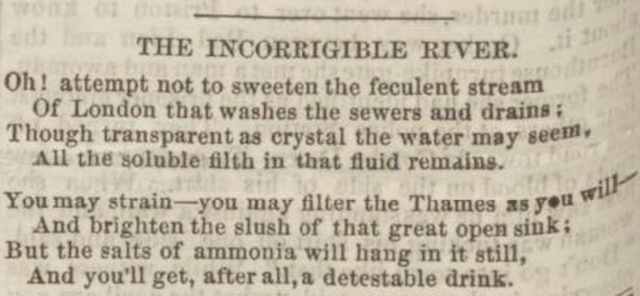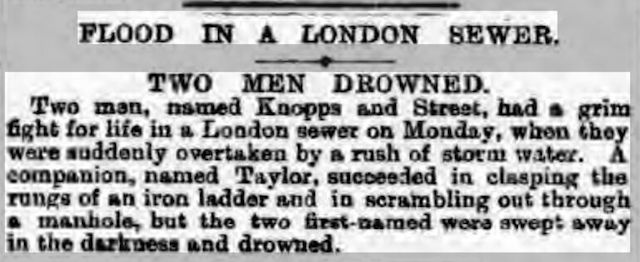
Londonist proudly presents a Shit's Miscellany of toilet trivia from the a(n)nals of our city.
An intrusion of turds
Before the advent of proper sewers and flushing toilets, going to the khazi was a dismal affair.
Chamber pots and cesspits were the noisome order of the day, and the smell of excrement must have been everywhere.
Samuel Pepys had a close encounter of the turd kind in 1660: "...and going down into my cellar to look, I put my foot into a great heap of turds, by which I find that Mr Turner's house of office is full and comes into my cellar, which doth trouble me...".
Mr Turner, the diarist's neighbour, had let his 'house of office' overflow, presenting Pepys with some poops.
The Hackney Arse-Wipe
As this plaque on White Post Lane attests, Hackney Wick was a pioneer of perforated loo roll.
The story is actually more complex with different companies in different locations all claiming some form of priority, but Hackney's got the plaque [update: since vanished, we think], so Hackney gets the plaudits.

In another coup-de-loo for the wider area, Andrex toilet tissue got its name from the Walthamstow street on which it was first made — St Andrew's Road.
Created in 1942, the puppy-rousing product was originally called Androll (St Andrew's-made roll), but later changed to the more familiar Andrex.
Bermondsey poopmongers
The streets of Victorian London were surprisingly free of dog poo.
The old 'muck = brass' equation found its most revolting solution in the leather trade. The process of tanning required copious amounts of excrement, colloquially known as 'pure', which leatherworkers would rub into the hides.
Pure collectors would scour the streets for canine waste, then cart it off to the centre of the leather trade in Bermondsey, where the eager tanners would offer cash for the honking payload.
Remember this next time you're tucking in to a home-made artisan brownie on one of Bermondsey Street's chichi cafes.
The Great Stink... in verse
Perhaps the most famous tale of human waste concerns the Great Stink of 1858, when the river ran so foul with excrement that the Houses of Parliament had to close — think of it like two similar magnetic poles of shite repelling one another.
That story, and the building of Bazalgette's sewers are copiously related elsewhere, so rather than go into detail, here's a poem from a lesser stink a few years before the Great Stink:

Drowned in sewage
In September 1908, a cry of alarm went up on Church Road, Leyton. Five-year-old Alfred Couch had fallen into a nearby sewage tank. The poor lad couldn't swim, and soon succumbed to the cackish waters.
A newspaper article of the time commends the "Noble action of the two boys who dived into the tank to rescue their playmate". Alas, the would-be-rescuers were unsuccessful.
Lots of people drowned in lots of sewage
A turbid tragedy of atrocious magnitude unfolded on the Thames in 1878.
The paddle steamer Princess Alice collided with a coal-carrying boat called the Bywell Castle off Tripcock Point, a little downriver of modern Thamesmead.
Around 650 people perished in the waters — easily the worst transport disaster in London's history. Their fate was made particularly grim by some 75 million gallons of raw sewage, dispensed into the river from nearby Barking and Crossness just an hour before.
The doomed vessel was, until recently, commemorated in the name of a Spitalfields pub, now sunk without trace to be replaced by the more aromatically associated Culpeper gastropub.
Artefacts from the disaster can be seen in the Museum of London Docklands, and a memorial can be found in Woolwich Cemetery.
Drowned in sewers
Because our sewers drain rainwater as well as household waste, they're prone to flash floods during heavy downpours. Many workers have succumbed to these sudden brown tides over the centuries. Here's one such incident from 1905, which occurred beneath Euston Road.

A feculent thought experiment
To what effluential purpose might we turn London's modern stockpile of poop?
First, let's work out how much dung we're dealing with. We can make the assumption that every Londoner (all 8 million of them) lays one turd per day, and that each deposit measures a mean length of 10 cm. Of course, not everyone defecates with such attention to periodicity and dimension, but any shortfall might be supplemented by invoking the tourist turd.
If laid end-to-end, then, London's daily arseburger output would stretch 800km. This would be enough to construct a 'soft shoulder' of biosolids four times around the M25, every day, assuming we could find a contractor willing to fulfil such a ghastly project.
With a week's collection, the coprolinear column could stretch 5,600km — almost precisely the distance from London to New York. However, a disproportionate number of 'floaters' would be needed to lay this most odorous of Transatlantic cables.
Photographs by M@. With thanks to Leigh Clothier for the Andrex story. Newspaper cuttings courtesy of the British Newspaper Archive.




